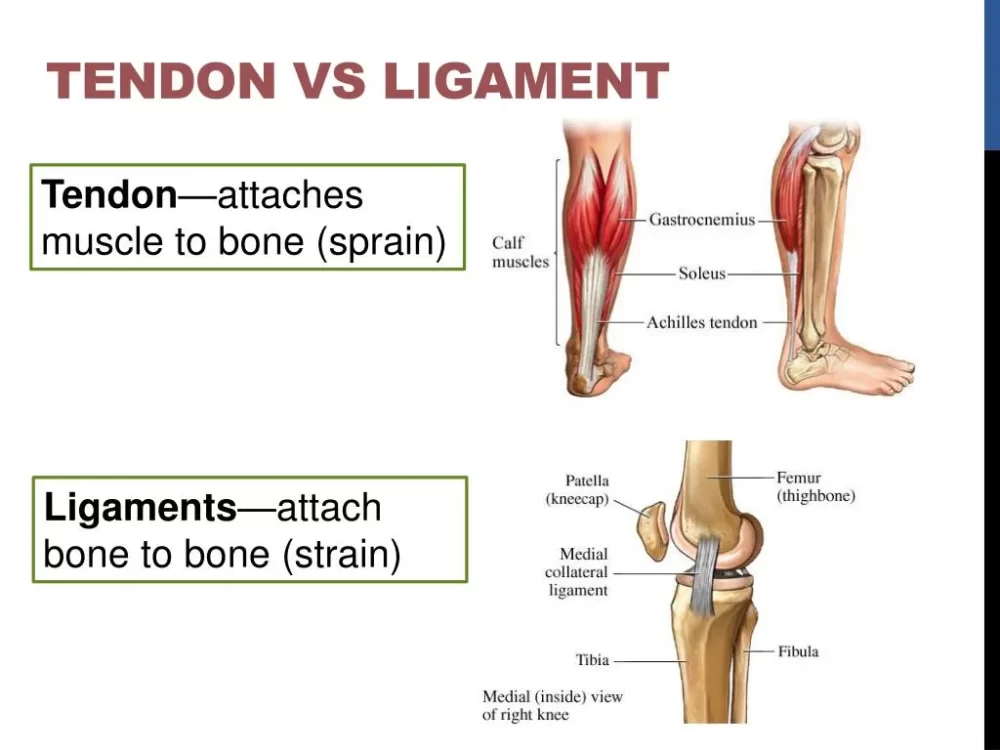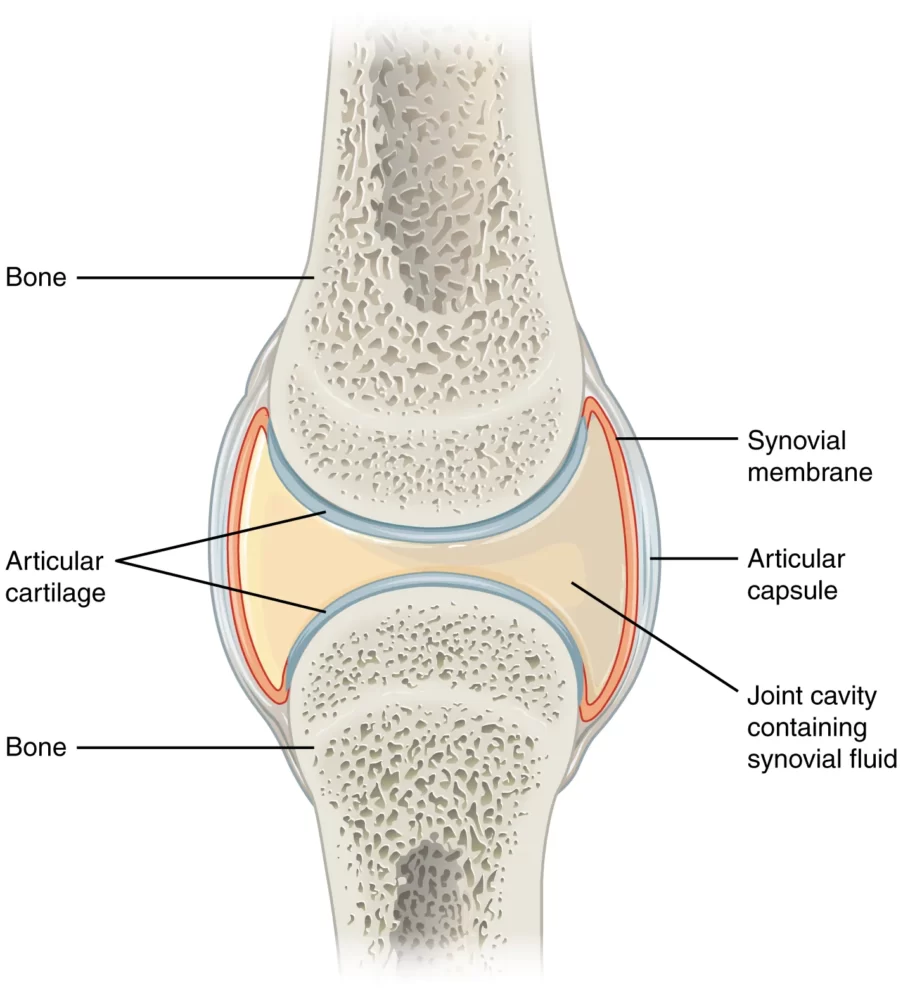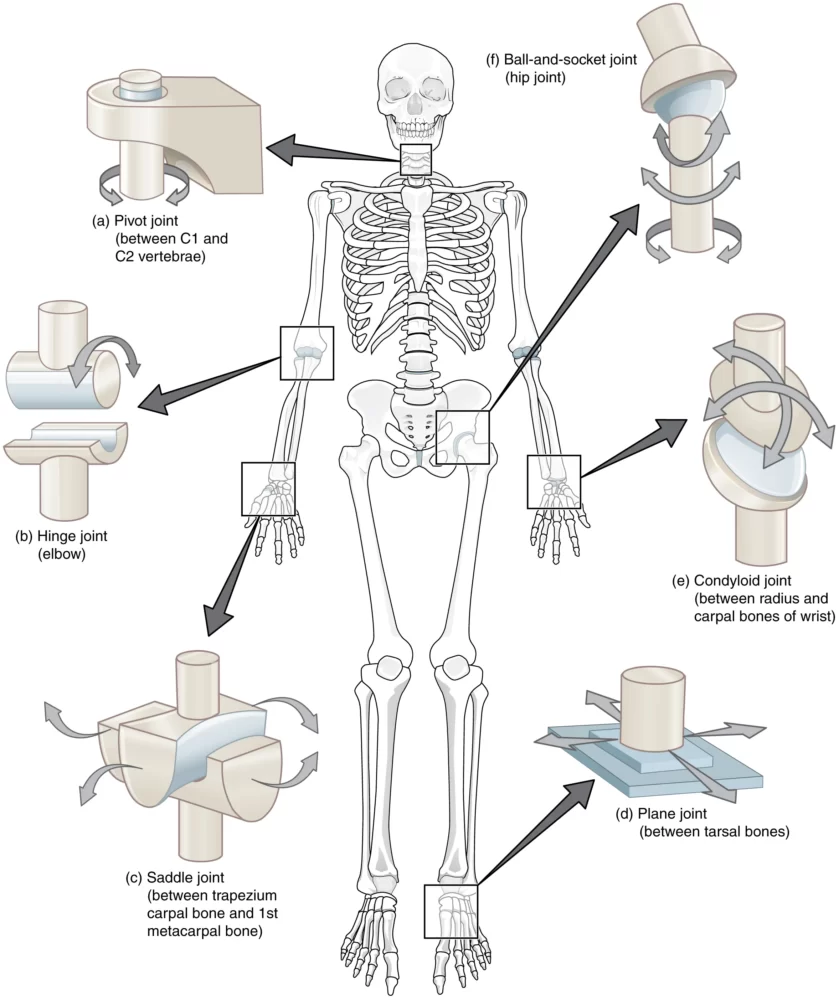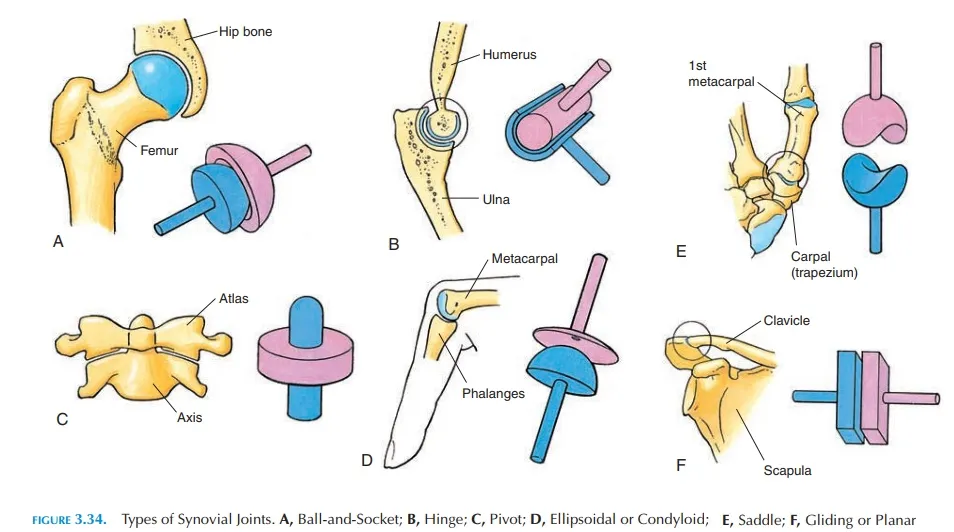In the field of biology, the study of the human body’s skeletal system plays a crucial role in various competitive exams like WBCS, SSC, UPSC, RAIL, and other important tests. Among the fundamental aspects of the skeletal system, understanding the different types of joints in the human body is vital for aspirants preparing for these exams.
Joints are pivotal in enabling movements and maintaining the body’s structural integrity. This blog post aims to delve into the classification of joints in the human body, providing clear explanations and relevant examples that will serve as valuable knowledge for those aspiring to excel in general science-based examinations. Let’s explore the fascinating world of joints and their significance in the functioning of the human body.

What Are Joints?
▪ A joint, also referred to as an articulation or articular surface, is a crucial connection between bones in the skeletal system, enabling movement.
▪ The various types of joints are categorized based on their structure and function, which determine the extent and manner of movement they allow.
▪ Joints significantly facilitate our body movements, including shoulder rotation, knee and elbow bending, neck swivelling, and more.
▪ Essentially, a joint serves as a meeting point between two bones, forming a framework that enables mobility.
▪ Ligaments are responsible for connecting bones to one another, while tendons attach muscles to bones.

Just Remember MTV (B) M - Muscles T- Tendons V(B) - Bones Tendons attach Muscles to Bones.
Classification of Joints
▪ Joints are classified based on their structure and function.
▪ The structural classification is determined by how the bones are connected.
▪ while the functional classification is based on the type of movement the joints facilitate.
▪ These classifications often overlap, as the structure of a joint largely influences its function.
Structural Classification of Joints
▪ The structural classification of joints depends on the tissue that binds the bones together at the joint. It includes three types: fibrous, cartilaginous, and synovial joints.
Fibrous Joints
▪ Fixed joints, also known as immovable joints, are located where bones lack flexibility.
▪ These joints occur when bones fuse together to create a solid structure.
▪ The skull is a prominent example of a fixed joint, composed of several fused bones.
▪ Additional examples of fixed joints include the upper jaw, rib cage, backbone, and pelvic bone.
Cartilaginous Joints
▪ Cartilaginous joints consist of two types: synchondrosis and symphysis joints.
▪ These joints are only found in areas where the connection between the articulating bones is made up of cartilage.
▪ Synchondrosis joints are temporary and are present in young children until the end of their puberty. For instance, the epiphyseal plates at the ends of long bones contribute to bone growth in children.
▪ On the other hand, symphysis joints are permanent and represent the secondary cartilaginous joints where bones join. Examples of symphysis joints include the pubic symphysis. Other cartilaginous joint examples involve the spinal column and the ribcage.
Synovial Joints
▪ A synovial joint, also known as diarthrosis, is a type of joint that connects bones or cartilage.
▪ It is enclosed by a fibrous joint capsule extending from the joined bones’ periosteum, forming the synovial cavity’s outer boundary.
▪ This cavity contains synovial fluid and surrounds the articulating surfaces of the bones.
▪ Synovial joints allow for free movement of long bones, providing greater mobility.
▪ The joint capsule consists of two layers: an outer fibrous membrane that holds the bones together structurally and an inner synovial membrane responsible for containing the synovial fluid.

▪ Synovial joints are distinguished by the presence of a synovial cavity, a fluid-filled space between the joint’s bones.
▪ A membrane encloses this cavity and contains synovial fluid, which provides added cushioning to the bone ends.
▪ Ligaments hold the bones together, while cartilage covers their articulating surfaces.
▪ Common examples of synovial joints include the knee, shoulder, neck, and wrist joints.
▪ These joints facilitate a wide range of movements, such as walking, running, and typing, due to their flexibility and ability to slide and rotate.
Structural Classification of Joints Summary:
| Joint Type | Description | Example |
|---|---|---|
| Fibrous Joints | Fixed joints, Immovable joints, bones fuse together to create a solid structure. Joints connected by fibrous connective tissue. | Skull, Upper jaw, Rib cage, Backbone, and Pelvic bone |
| Cartilaginous Joints | Joints connected by cartilage. only found in areas where the connection between the articulating bones is made up of cartilage. | Spinal column, Ribcage, |
| Synovial Joints | A synovial joint, also known as diarthrosis, is a type of joint that connects bones or cartilage. | The knee joint, elbow joint, Shoulder joint |
Functional Classification of Joints
▪ Joints are functionally classified based on the type and extent of movement they permit.
▪ There are three main types in this classification: immovable, partly movable, and movable joints.
Immovable Joints
▪ Immovable joints, primarily fibrous joints, allow little to no movement.
▪ Examples of immovable joints include those between the bones of the cranium, the tibia and fibula in the lower leg, and the radius and ulna in the lower arm.
Partly Movable Joints
▪ Partly movable joints, mainly cartilaginous joints, permit slight movement.
▪ Examples of partly movable joints include those between vertebrae and the joints between the ribs and sternum (breastbone).
Movable Joints
▪ Movable joints, all of which are synovial joints, enable bones to move freely.
▪ They are the most common type of joints in the body, including the knee, shoulder, hip, and elbow.
Functional Classification of Joints Summary
| Functional Classification | Description | Example |
|---|---|---|
| Synarthroses | Immovable joints with little or no movement. | Sutures in the skull, where bones are tightly fused. |
| Amphiarthroses | Slightly movable joints with limited mobility. | Pubic symphysis, where the pelvis bones connect. |
| Diarthroses | Freely movable joints with a wide range of motion. | Ball-and-socket joint (shoulder, hip), Hinge joint (knee, elbow). |
Types of Movable Joints
▪ The type and extent of movement determines the functional classification of joints they allow. There are six types of freely movable joints, each with specific examples, as mentioned below:
Ball and Socket or Sphenoid Joint
▪ The ball-and-socket joint, also known as the spheroid joint, is a synovial joint where the rounded surface of one bone fits into the cup-like depression of another bone.
▪ This joint allows the distal bone to move around multiple axes, all centred at a common point, resulting in a wide range of movements in various directions.
▪ A ball-and-socket joint is the most mobile type of synovial joint, allowing for movement in all directions.
▪ Ball-and-socket joints are found in the hip and shoulder joints.

Pivotal Joints
▪ Pivotal joints enable movement where one bone is inserted into another, but full rotation is restricted. These joints facilitate sideways and back-forth movements, as seen in the neck.
▪ There are only three pivot joints in the human body. They are located in the neck, wrist, and elbow.
- Atlantoaxial joint. This joint is located between the atlas and axis vertebrae, the first two vertebrae in the neck. It allows the head to rotate from side to side.
- Radioulnar joint. This joint is located in the wrist and allows the forearm to rotate.
- Humeroulnar joint. This joint is located in the elbow and allows the forearm to rotate.
▪ Pivot joints are synovial joints, which means they are lined with a synovial membrane that produces synovial fluid. Synovial fluid helps to lubricate the joint and reduce friction.
▪ Pivot joints allow for rotation around a single axis.
▪ This type of movement is important for many tasks, such as looking around, unscrewing a lid, and swinging a bat.

Hinge or Ginglymus Joints
▪ Hinge joints, also known as ginglymus joints, are synovial joints that allow for movement in one plane only. This is similar to how a door hinge allows a door to swing open and closed.
▪ Hinge joints are found in many body parts, including the elbows, knees, ankles, and interphalangeal joints (IP joints) of the fingers and toes.
▪ The bones that make up a hinge joint are shaped like a wedge, with one bone being wider than the other.
▪ The wider bone has a rounded articular surface that fits into the narrower bone. This allows the bones to move back and forth in one plane, like a door hinge.
▪ Hinge joints are held in place by ligaments, which are tough bands of tissue that connect the bones together. The ligaments of a hinge joint prevent the bones from moving too far in any direction, which helps to protect the joint from injury.
Saddle Joints
▪ A saddle joint is a type of synovial joint that allows for movement in two planes. This is similar to the way a saddle allows a rider to sit and move in different directions.
▪ Saddle joints are found in a few places in the body, including the carpometacarpal joint of the thumb, sternoclavicular, and incudomalleolar joint.
▪ The bones that make up a saddle joint are shaped like a saddle, with one bone having a concave surface and the other having a convex surface. This allows the bones to move in two planes: flexion/extension and abduction/adduction.
▪ Saddle joints are held in place by ligaments, which are tough bands of tissue that connect the bones together. The ligaments of a saddle joint prevent the bones from moving too far in any direction, which helps to protect the joint from injury.
Ellipsoidal or Condyloid joints
▪ Ellipsoidal or condyloid joints are synovial joints that allow movement in two axes.
▪ These joints feature an oval-shaped projection of one bone fitting into the elliptical cavity of another bone.
▪ This unique structure enables movements in up-down and side-to-side directions, providing flexibility and versatility to the joint.
▪ Examples of ellipsoidal joints can be found in the base of the index finger, wrist, and elbow.
Gliding Joints
▪ Gliding joints, also known as plane or planar joints, are a common type of synovial joint. These joints permit smooth movement between two or more flat or round bones, allowing them to glide freely together without any friction or crushing of bones.
▪ Gliding joints are primarily found in regions where bones meet and slide on one another in various directions.
▪ Examples of gliding joints include the joint between the carpal bones, tarsal bones, the sternum and clavicle, and the scapula and clavicle.
▪ These joints play a significant role in facilitating movements that involve sliding or gliding actions, contributing to the overall mobility of the human body.

The Function of Joints in the Human Body
▪ The main function of joints in the human body is to allow for movement.
▪ Joints are formed where two or more bones meet, and ligaments hold them together.
▪ The different types of joints allow for different ranges of motion, depending on the needs of the body part.
Here are some of the functions of joints in the human body:
Allow for movement: Joints allow us to move our bodies in various ways. Thanks to our joints, we can walk, run, jump, dance, and even type on a keyboard.
Provide stability: Joints also help to provide stability to the body. They help to keep our bones in place and prevent them from moving too much. This is important for balance and coordination.
Absorb shock: Joints also help to absorb shock. This is important for protecting our bones and joints from injury.
Lubricate the joints: Joints are lined with synovial fluid, which helps to lubricate the joints and reduce friction. This allows the bones to move smoothly against each other.
Provide nutrients to the bones: Joints also help to provide nutrients to the bones. The synovial fluid that lines the joints contains nutrients essential for bone health.
Joints are essential for our ability to move and function. They help us to perform everyday activities, such as walking, running, and lifting objects. They also help to protect our bones and joints from injury.
Frequently Asked Questions
Fibrous joints are mainly referred to as those joints which are fixed and immovable.
There are three types of immovable joints:
• Sutures
• Gomphosis
• Syndesmosis
Synovial joints are classified into 6 different categories based on their shape and structure:
• Planar joints
• Hinge joints
• Pivot joints
• Condyloid joints
• Saddle joints
• Ball-and-socket joints.
A joint is a point or location in the body where two or more bones meet.
Ball-and-socket joints include the Elbow, Neck, Knee, Shoulder, Thumb, Hip, Wrist and Intercarpal joints.
The primary function of joints is to connect bones within our body. Apart from this, it also helps us to move, rotate, and also bear weight.
There are 3 different types of Joints and they are classified mainly based on their mobility:
• Fibrous Joints or Fixed Joints
• Synovial joints or freely movable joints
• Cartilaginous Joints or Slightly Moveable Joints.

